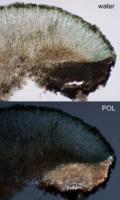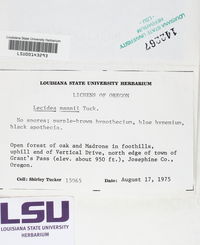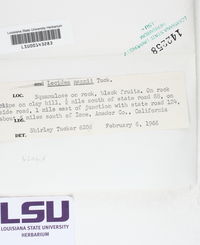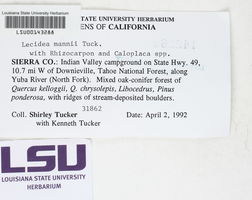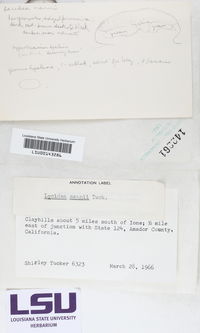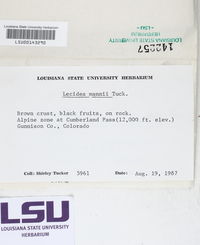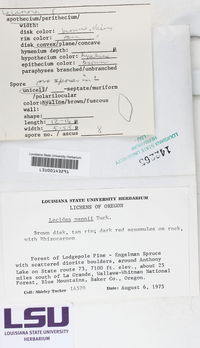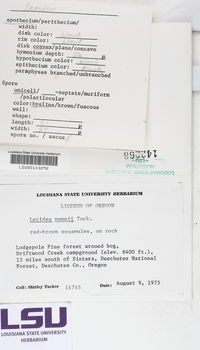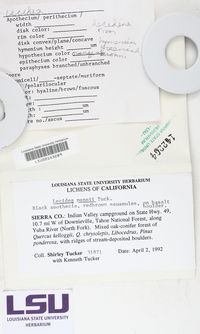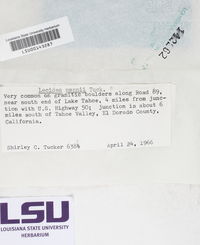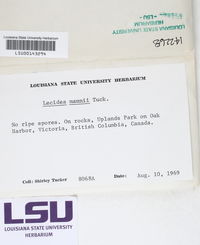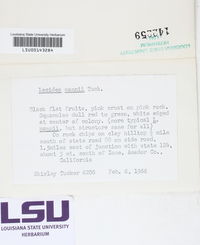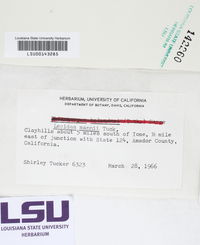
Consortium of Lichen Herbaria
- building a Global Consortium of Bryophytes and Lichens as keystones of cryptobiotic communities -
- Home
- Search
- Images
- Species Checklists
- US States: O-Z >
- US National Parks
- Central America
- South America
- US National Parks
- Southern Subpolar Region
|
|
|
|
Family: Lecideaceae
|
Nash, T.H., Ryan, B.D., Gries, C., Bungartz, F., (eds.) 2004. Lichen Flora of the Greater Sonoran Desert Region. Vol 2. Thallus: crustose, regularly areolate, rarely subsquamulous, rarely subbullate, sometimes rather thin (0.2 mm); prothallus: black, rather indistinct, usually not discernible areoles: usually flat, up to 1.5(-3) mm in diam. surface: pale ochre to pale brown, sometimes with an olive (rarely reddish one or grayish) tinge, smooth, usually a bit glossy (Lecidea atrobrunnea appearance), esorediate medulla: white, I- Apothecia: black, with a moderately to slightly or without a markedly constricted base, occurring between the areolae, mean diam. 0.5-1.5 mm, maximum diam. 0.7-3.9 mm disc: black, flat to moderately convex, dull, epruinose to pruinose margin: black or more often pale on outside, long persistent, dull to shiny, sometimes undulate in old apothecia exciple: dark olive-gray or brownish black peripherally in a 12-30 µm thick rim, unpigmented inside but ochre opaque due to fine crystalline masses (eventually dissolving in K), C+ red (sometimes rather weak), 45-80 µm wide; sometimes with some algal cells inside epihymenium: olive-green to (bright) green (cinereorufa-green usually present), 12-15 µm thick hymenium: hyaline, 50-75 µm tall, I+ blue; paraphyses: simple, rather rarely branched and anastomosing subhymenium: often difficult to measure, 25-60 µm thick hypothecium: hyaline to pale brown below, 60-150 µm thick asci: clavate, 40-65 x 12-15 µm, 8-spored ascospores: hyaline, simple, ellipsoid, (9-)10-15(-22) x (4-)5- 6.7(-11) µm, length-widthratio 1.6-2.8: 1 Pycnidia: immersed conidia: cylindrical, (8-)8.5-13(-17) x 1-1.3 µm [studied in 8 specimens] Spot tests: cortex and medulla K-, C+ red or C-, P- Secondary metabolites: gyrophoric and schizopeltic acid (schizopeltic acid rarely in small amounts or not detectable). Substrate and ecology: in open habitats on granites, schist and other acidic rocks World distribution: coastal, western U.S.A., Baja California, coastal Chile, and Patagonia Sonoran distribution: not rare in coastal areas from southern California to Baja California. Notes: Morphologically Lecidea mannii resembles Lecidea atrobrunnea and even more Lecidea fuscoatra, but it differs from Lecidea atrobrunnea in having larger ascospores, a taller hymenium, I- and (usually) C+ red medulla and from Lecidea fuscoatra by its unpigmented hypothecium. The species was named after H. Mann, its first collector. |
Powered by Symbiota


